Jiaozhou Bay
The Jiaozhou Bay (simplified Chinese: 胶州湾; traditional Chinese: 膠州灣; German: Kiautschou Bucht, 36°7′24.44″N 120°14′44.3″E) is a bay located in Qingdao (Tsingtau), China. It was a German colonial concession from 1898 until 1914.
| Jiaozhou Bay | |||||||||||||||||||||||
|---|---|---|---|---|---|---|---|---|---|---|---|---|---|---|---|---|---|---|---|---|---|---|---|
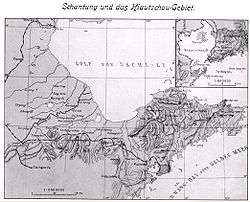 | |||||||||||||||||||||||
| Chinese name | |||||||||||||||||||||||
| Simplified Chinese | 胶州湾 | ||||||||||||||||||||||
| Traditional Chinese | 膠州灣 | ||||||||||||||||||||||
| Postal | Kiaochow Bay Kiautschou Bay (1898–1922) | ||||||||||||||||||||||
| |||||||||||||||||||||||
| German name | |||||||||||||||||||||||
| German | Kiautschou Bucht | ||||||||||||||||||||||
Jiaozhou is the main town of the bay area, which was historically romanized as Kiaochow, Kiauchau or Kiao-Chau in English and Kiautschou in German.
Geography and ecology
Jiaozhou Bay is a natural inlet of the Yellow Sea (German: Gelbes Meer), with 10 to 15 meters depth to the seabed and deeper, dredged channels to three major ports around the bay: Qingdao, Huangdao, and Hongdao, all of which are ice-free during winter.
It is located on the southern coast of the Shandong Peninsula (German: Schantung Halbinsel) in East China, and separates Huangdao District from Qingdao City and borders on Jiaozhou City.
The bay is 32 km long and 27 km wide with a surface area of 362 km2, approximately two-thirds the area of 100 years ago. According to official data,[1] the surface area has decreased from 560 km2 in 1928 to 362 km2 by 2003 due to sustained land reclamation activities in recent decades.
The marine species have also decreased by two-thirds during the last 50 years[2] due to urban and industrial development and growth of adjacent areas around the bay. Out of 170 species of organisms found in the northwestern part of the basin during the 1970s, only 17 were found in 1989.[3] False killer whales still occasionally appear in the waters[4] which were a regular range for the species until the 1980s.[5] On the other hand, Jiaozhou Bay may serve as a suitable location for studying recoveries of coastal marine ecosystems.[6]
History
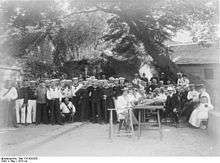
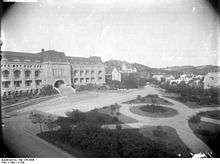
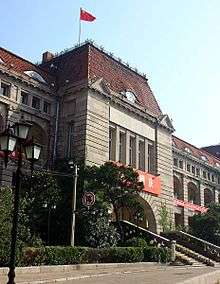
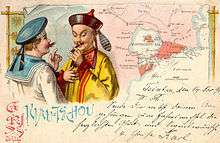
Jiaozhou Bay was known formerly as Jiao'Ao. The area became widely known to Europeans after the German Empire in March 1898 concluded a lease with the Qing government of China.
The area was transferred to German rule on a 99-year lease (or until 1997, as the British did in Hong Kong's New Territories and as the French did in Kouang-Tchéou-Wan), and it became known as the Kiautschou Bay concession. The village of Tsingtau became the German colony of Tsingtau, and the area became a focus for German commercial development in China, while for the Imperial German Navy it was the base for their Far East Squadron.
Because of land speculation in Germany's African colonies, a land value tax was introduced as the only tax in the colony. It was a great success, bringing wealth quite rapidly to the colony and also financial stability.[7] The colony was the only government authority ever to exclusively rely on the single tax on land value, and is used as an academic case study to this day about the viability of such a tax system. The German colony also issued currency.[8][9]
With the outbreak of World War I, the Republic of China canceled the Kiautschou lease with the German Empire. This came into force on 23 August 1914, the day of Japan’s declaration of war on Germany, after a Japanese ultimatum for unconditional German evacuation of the colony had expired. Following a two month military siege by British and Japanese forces, the colony was forced to surrender. It was then occupied by the British and Japanese.
The Republic of China declared war on Imperial Germany on 14 August 1917, since as an member of the victorious allies, China fully expected the former German colony would be returned to them. Instead, the Treaty of Versailles acceded to Japanese demands at the Paris Peace Conference and assigned all former German Pacific territories and islands north of the equator to Japan, including Jiaozhou Bay.[10] This unexpected decision led to China-wide protests known as the "May Fourth Movement", which is now regarded as a significant event of modern Chinese history. As a result, the Beiyang government refused to sign the Treaty.[11]
This situation was known as the "Shandong Problem". It eventually was resolved through mediation by the United States, which led to the former colony's return to Chinese sovereignty in February 1922.
Connection project
Jiaozhou Bay is situated wholly within Qingdao prefecture. Counterclockwise, the bordering divisions are Shinan District, Shibei District, Sifang District, Licang District, Chengyang District, Jiaozhou City, Jiaonan City and Huangdao District. The entrance to the bay is 6.17 km wide. In 1993, Qingdao City decided to build a traffic corridor for the Jiaozhou Bay region, which includes a tunnel under the inlet and a bridge across Jiaozhou Bay. In December 2006 the construction process started with an estimated completion target of 2011.
- The Jiaozhou Bay Bridge, at 42.5 kilometers (26.4 mi), is the world's longest bridge over water, surpassing the cross-sea Donghai Bridge in length. The total budget is estimated at approximately 9.938 billion yuan (~US$1.5 billion[12]). It is estimated that it will shorten travel time from Qingdao to the outlying region by more than half and relieve pressure on the existing Jiaozhou Bay Expressway.
- The Qing-Huang Tunnel will connect Qingdao with Huangdao with a length of over 7 km; with 3 billion yuan (~US$440 million) budgeted for its construction. After completion, travel time is estimated at approximately 10 minutes by automobile from Qingdao to Huangdao District.
Notes
- China State Oceanic Administration "Chorography of Jiao'Ao"
- http://www.soa.gov.cn/hyjww/zghybnew/ywb/webinfo/2008/11/1225332542195401.htm%5B%5D
- Kaiya Z.; Leatherwood S.; Jefferson A.T. (2002). Perrin F.W.; Reeves R.R.; Dolar L.L.M.; Jefferson A.T.; Marsh H.; Wang Y.J.; Estacion J. (eds.). "Report of the Second Workshop on The Biology and Conservation of Small Cetaceans and Dugongs of South-East Asia" (PDF). CMS Technical Series Publication Nº 9 at Convention on Migratory Species. Archived from the original (PDF) on 4 March 2016. Retrieved 6 January 2015.
- 一个男人在流浪. 2017. 「北冥有鲲」古人见过鲸么?. Zhihu. Retrieved on October 03, 2017
- 青岛海水水质变好引来"深海贵客" 鲸鱼群嬉水胶州湾(组图). News.sina.com.cn. Retrieved on August 29, 2016
- North Pacific Marine Science Organization. 2002. PICES Scientific Report No. 22 2002 - PICES Science: The first ten years and a look to the future (pdf). Perry I. R.. Livingston P.. Bychkov S. A.. PICES Secretariat. Retrieved on February 27, 2017
- "Archived copy". Archived from the original on 10 January 2014. Retrieved 24 October 2012.CS1 maint: archived copy as title (link)
- Owen Linzmayer, Bank Note Book - Kiau Chau chapter, 7-page catalogue covering notes issued by the Deutsch-Asiatische Bank (German-Asian Bank) from 1907 to 1914, and the Greater Japan Imperial Government in 1914. Published 19.01.2018.http://www.coinbooks.org/v21/club_nbs_esylum_v21n03.html#article6
- See coins in the British Museum collection. http://www.britishmuseum.org/research/collection_online/collection_object_details.aspx?objectId=3606982&partId=1&place=37200&plaA=37200-2-11&page=1
- Coco, Orazio (22 May 2020). "German Imperialism in China: the leasehold of Kiaochow Bay (1897–1914)". The Chinese Historical Review: 1–19. doi:10.1080/1547402X.2020.1750231.
- Coco, Orazio (22 May 2020). "German Imperialism in China: the leasehold of Kiaochow Bay (1897–1914)". The Chinese Historical Review: 1–19. doi:10.1080/1547402X.2020.1750231.
- per XE.com Universal Currency Converter, July 2009
External links
- German colonies (in German)
- Jiaozhou Bay Connection Project (in Chinese)
